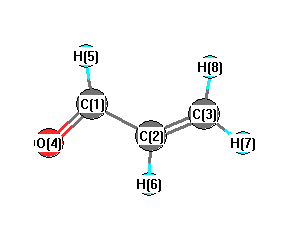.
| squib |
reference |
DOI |
| 1966Che/Cos:104 |
EA Cherniak, CC Costain, "Microwave Spectrum and Molecular Structure of trans-Acrolein" J. Chem. Phys. 45, 104, 1966 |
10.1063/1.1727291 |
| 1971Fly/Ben:225 |
WH Flygare, RC Benson "The molecular Zeeman effect in diamagnetic molecules and the determination of molecular magnetic moments (g values), magnetic susceptibilities, and molecular quadrupole moments" Mol. Phys. 1971, 20 (2), 225-250 |
10.1080/00268977100100221 |
| 1982Blo/Bau:55-58 |
CE Blom, A Bauder "MICROWAVE SPECTRUM, ROTATIONAL CONSTANTS AND DIPOLE MOMENT OF S-CIS ACROLElN" |
|
| 1984Blo/Gra:7427-7431 |
CE Blom, G Grassi, A Bauder "Molecular Structure of s-cis- and s-trans-Acrolein Determined by Microwave Spectroscopy" J. Am. Chem. Soc. 1984, 106, 24, 7427-7431 |
10.1021/ja00336a022 |
| 1998Gus/Rui:163 |
M Gussoni, R Rui, G Zerbi "Electronic and relaxation contribution to linear molecular polarizability. An analysis of the experimental values" J. Mol. Struct. 447 (1998) 163-215 |
10.1016/S0022-2860(97)00292-5 |
| TRC |
Frenkel, M; Marsh, K.N.; Wilhoit, R.C.; Kabo, G.J.; Roganov, G.N.,Thermodynamics of Organic Compounds in the Gas State,Thermodynamics Research Center, College Station, TX, 1994 |
|
| webbook |
NIST Chemistry Webbook (http://webbook.nist.gov/chemistry) |
10.18434/T4D303 |












